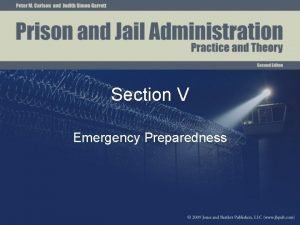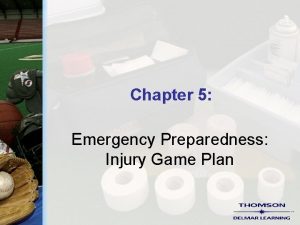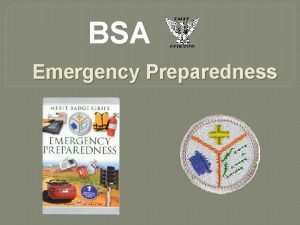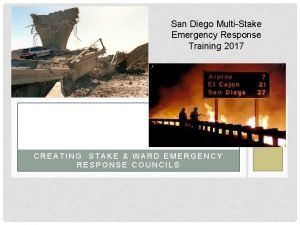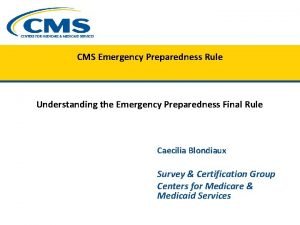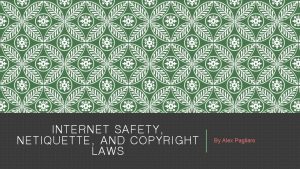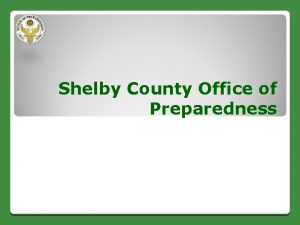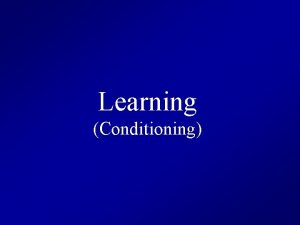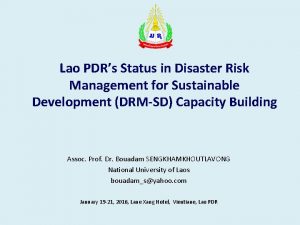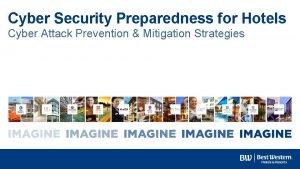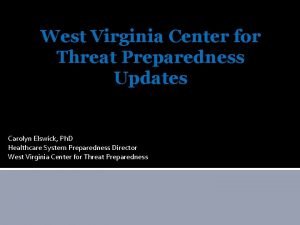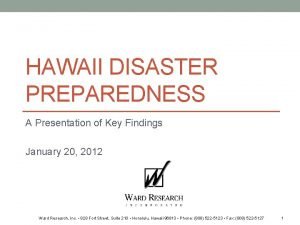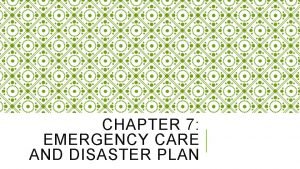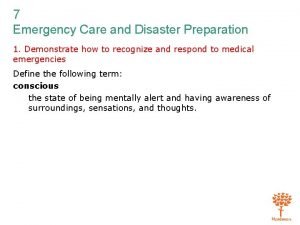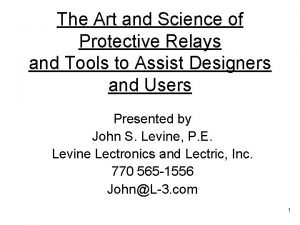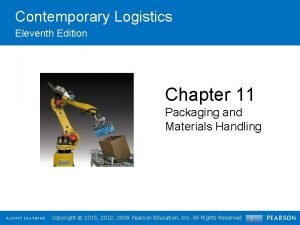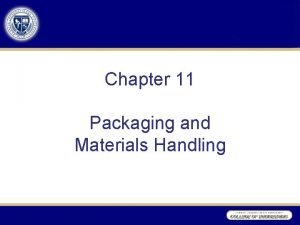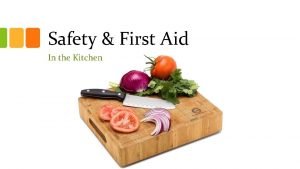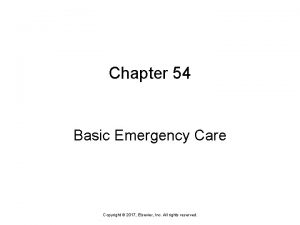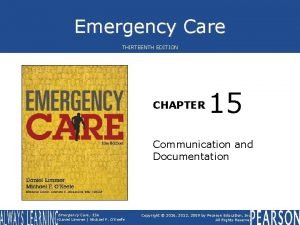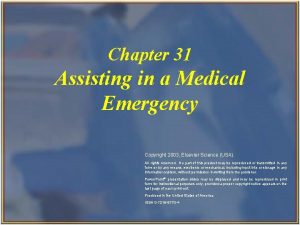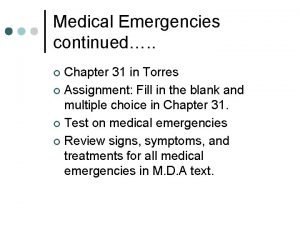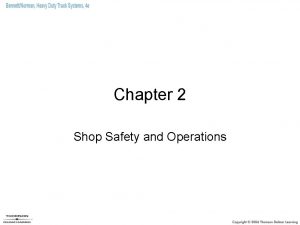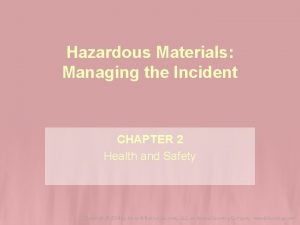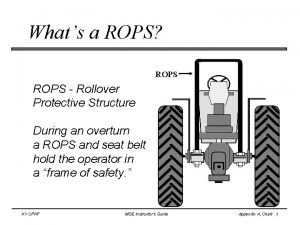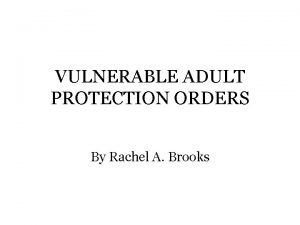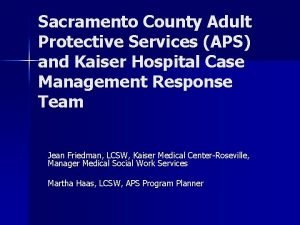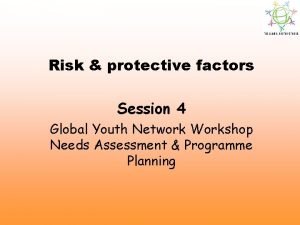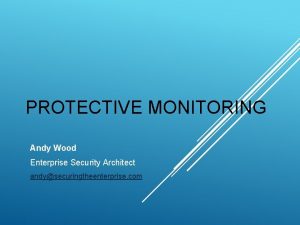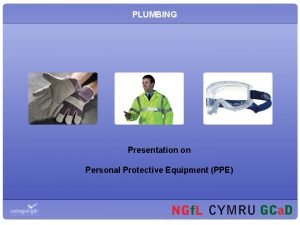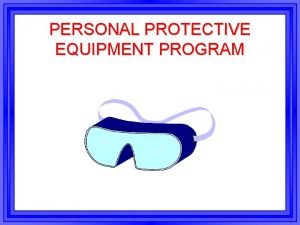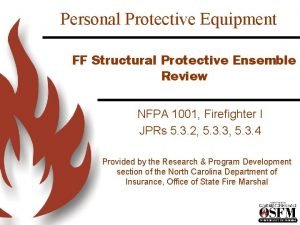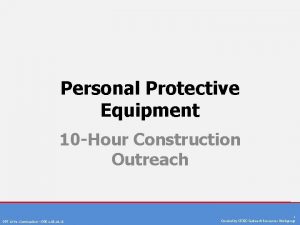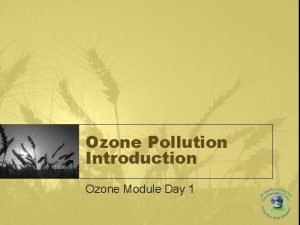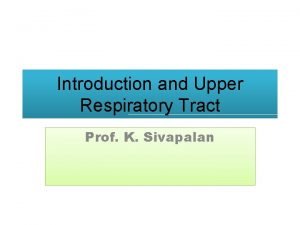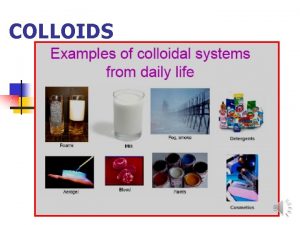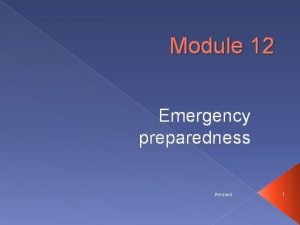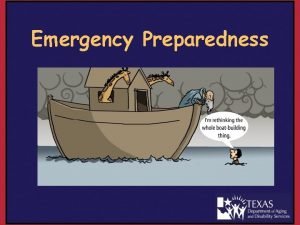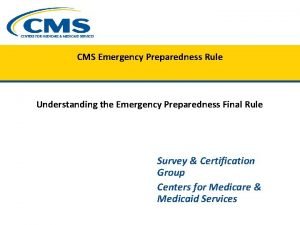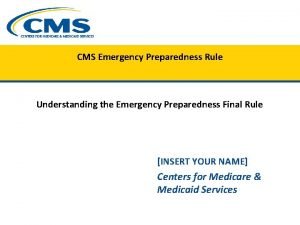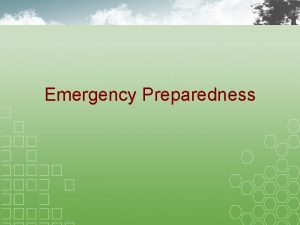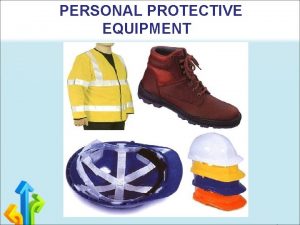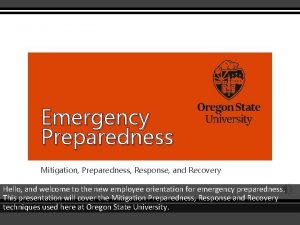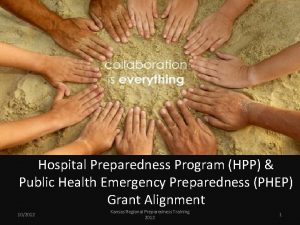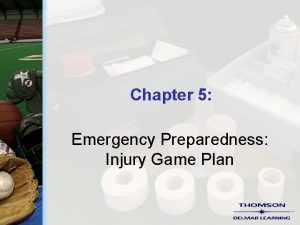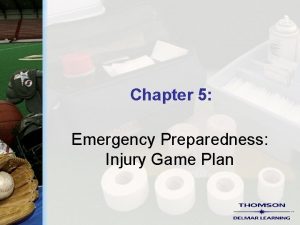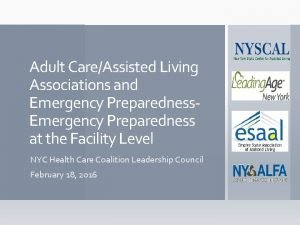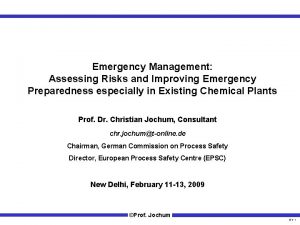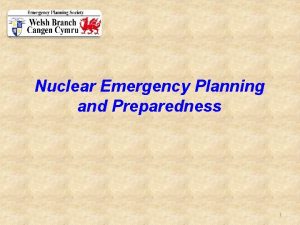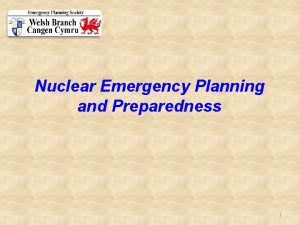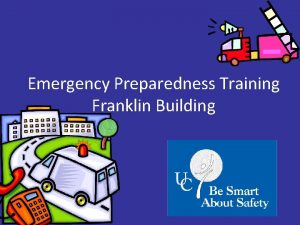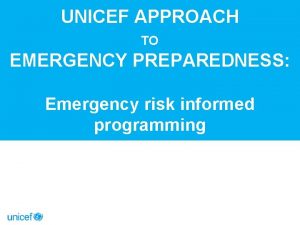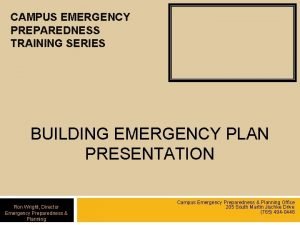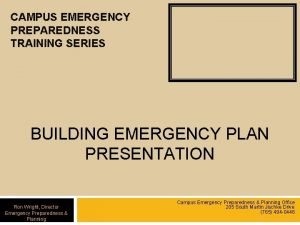Chapter 36 Emergency Preparedness and Protective Practices Copyright



























































- Slides: 59

Chapter 36 Emergency Preparedness and Protective Practices Copyright 2016 by Elsevier Inc. All rights reserved. 1

Lesson 36. 1 Objectives State the effect a disaster or serious emergency can have on a health care facility. Explain the different between a natural disaster and a man-made disaster and list examples of each. List the characteristics of a disaster that tend to cause the most serious psychological effects. List and describe three phases of the generalized adaptation syndrome. Copyright 2016 by Elsevier Inc. All rights reserved. 2

Lesson 36. 1 Objectives List and describe the stages of anxiety and the intervention that should be employed for each. State the purpose of an emergency action plan. List and describe the six elements that must be included in an emergency action plan. List and describe three components of an emergency evacuation plan. Copyright 2016 by Elsevier Inc. All rights reserved. 3

Lesson 36. 1 Objectives Identify the information that should be included on an evacuation floor plan. State the duties that may be performed by evacuation wardens in the medical office. Copyright 2016 by Elsevier Inc. All rights reserved. 4

Introduction to Disaster and Emergency Planning Possibility of a disaster or serious emergency at health care facility May cause damage and/or threaten employees, patients, buildings May cause harm or inability provide usual services Copyright 2016 by Elsevier Inc. All rights reserved. 5

Introduction to Disaster and Emergency Planning Organizations must plan ahead to: Minimize damage Facilitate recovery So that services can be restored as efficiently as possible Copyright 2016 by Elsevier Inc. All rights reserved. 6

Categories of Disasters Hazards are categorized as natural or man-made Natural disaster: Results from a natural hazard Examples: volcanoes, tornados, earthquakes, hurricanes Causes significant damage to the environment Leads to environmental, financial, and human losses Copyright 2016 by Elsevier Inc. All rights reserved. 7

Categories of Disasters Man-made disaster Refers to serious damage either directly or indirectly caused by: Intentional or negligent human actions Failure of a man-made system Examples: fire, structural collapse, terrorism Copyright 2016 by Elsevier Inc. All rights reserved. 8

Natural Disasters May occur with or without warning Earthquakes: usually occur without warning Hurricanes: develop over a period of days Allows for some preparation Copyright 2016 by Elsevier Inc. All rights reserved. 9

Natural Disasters Must prepare when a hurricane or tornado is in the area Exact track of the storm is difficult to predict Medical office employees must be educated About the response to take to the types of natural disasters That tend to occur in their geographic area Copyright 2016 by Elsevier Inc. All rights reserved. 10

Man-made Disasters Amount of threat or damage from man-made hazards Can vary considerably – examples Fire in a wastebasket Gunman Bomb threat Radiation incident Copyright 2016 by Elsevier Inc. All rights reserved. 11

Man-made Disasters Types of man-man hazards: Crime Fire Terrorism Industrial hazards Structural collapse Power outage Radiation hazards Chemical contamination Copyright 2016 by Elsevier Inc. All rights reserved. 12

Psychological Effects of Emergencies Positive reaction to an emergency Triggering of resources to meet the challenges Negative reaction to an emergency Often occurs when physical and emotional resources are depleted Copyright 2016 by Elsevier Inc. All rights reserved. 13

Psychological Effects of Emergencies Disasters that cause the most serious psychological effects are those that: Occur without warning Pose a serious threat to personal safety or have unknown health effects Have an uncertain duration Result from malicious intent or human error Involve a symbol (such as the 9/11 attacks) Copyright 2016 by Elsevier Inc. All rights reserved. 14

The Stress Response Stress: The body's response to threat or change Body’s response to stress: general adaptation syndrome (GAS) Copyright 2016 by Elsevier Inc. All rights reserved. 15

The Stress Response Alarm phase Body senses a stress and begins to react Epinephrine is released, which stimulates the sympathetic nervous system Pupils dilate Heart beats faster Respirations become faster and deeper Blood pressure rises Body prepares to fight or run away Individual’s attention becomes narrowly focused on the perceived threat Copyright 2016 by Elsevier Inc. All rights reserved. 16

The Stress Response Resistance phase Stress remains, but the body adapts May occur within hours or days Levels of adrenal hormones may Remain slightly high Drop back to normal Copyright 2016 by Elsevier Inc. All rights reserved. 17

The Stress Response Recovery or Exhaustion phase Parasympathetic system begins to regain control Body returns to normal level of function Copyright 2016 by Elsevier Inc. All rights reserved. 18

The Stress Response If stress persists causes: Increase in blood pressure Elevated glucose level Increased metabolism Increased pressure within the eye Leads to fatigue, hunger, and headaches Copyright 2016 by Elsevier Inc. All rights reserved. 19

The Stress Response Chronic stress Body is unable to maintain the response Immune system is compromised Individual is more prone to a variety of illnesses Copyright 2016 by Elsevier Inc. All rights reserved. 20

Managing Anxiety: normal part of the "fight or flight response" Anxiety: A feeling of worry or uneasiness, often triggered by an event with an uncertain outcome Individual who is moderately to severely anxious Not able to notice details Not able to think as clearly Emergency procedures that have been learned and practiced Keep anxiety level from rising Copyright 2016 by Elsevier Inc. All rights reserved. 21

Managing Anxiety Severe anxiety in an emergency situation Tends to immobilize an individual Stimulates anxiety in others Symptoms of an anxiety attack: Hyperventilation Rapid heart rate Unresponsive Assist highly anxious person Give the anxious person directions in short sentences Help person to breathe deeply Direct the person where to go if: a dangerous area must be evacuated; the person should take cover Copyright 2016 by Elsevier Inc. All rights reserved. 22

Emergency Action Plan Required by OSHA for almost all businesses Must include: Means of reporting fires and other emergencies Evacuation procedures and emergency escape routes Copyright 2016 by Elsevier Inc. All rights reserved. 23

Emergency Action Plan Must include: Procedures for employees who remain For critical operations that need to be completed A way to account for all employees after evacuation Designation of rescue and medical duties Who to contact for additional information or clarification Copyright 2016 by Elsevier Inc. All rights reserved. 24

Emergency Action Plan Components of an emergency action plan Preferred mean of reporting fires and other emergencies Dialing 911 Dialing internal emergency phone numbers Activation of manual alarm system Copyright 2016 by Elsevier Inc. All rights reserved. 25

Emergency Action Plan Components of an emergency action plan Emergency evacuation procedures Type of evacuation Exit routes – an evacuation floor plan is necessary Copyright 2016 by Elsevier Inc. All rights reserved. 26

Emergency Action Plan Evacuation floor plan should include the following: Employee’s current location Primary and secondary exit routes Manual fire alarm boxes Portable fire extinguishes Emergency exit doors Copyright 2016 by Elsevier Inc. All rights reserved. 27

Emergency Action Plan Evacuation floor plan should include the following: Wheelchair accessible exits Shelter-in-place areas Assembly areas Copyright 2016 by Elsevier Inc. All rights reserved. 28

Emergency Action Plan Components of an emergency action plan Procedures for employees who remain behind to perform critical operations before evacuation Procedures to account for all employees after an evacuation Copyright 2016 by Elsevier Inc. All rights reserved. 29

Emergency Action Plan Components of an emergency action plan Procedures for employees performing rescue or medical duties Known as evacuation wardens Individuals who can be contacted for further information under the plan Copyright 2016 by Elsevier Inc. All rights reserved. 30

Lesson 36. 2 Objectives List and describe the elements of a fire. State the five elements that must be included in a fire prevention plan. Identify methods of fire prevention for the medical office. List and describe safety measures used for fire protection in the medical office. Copyright 2016 by Elsevier Inc. All rights reserved. 31

Lesson 36. 2 Objectives List and describe the five classes of fire. Identify the steps included in the RACE response. Identify the education and training that must be provided to medical assistants related to medical office emergency situations. Copyright 2016 by Elsevier Inc. All rights reserved. 32

Lesson 36. 2 Objectives State the purpose of emergency practice drills. Describe the role of the medical assistant in disasters and serious emergencies. Copyright 2016 by Elsevier Inc. All rights reserved. 33

Fire Safety in the Medical Office Common fire hazards in the medical office Heating equipment that is: Poorly maintained Too close to flammable materials Overloaded electrical circuits Improper use of stoves or microwave ovens Improper storage of oxygen Cleaning supplies and other combustible materials Copyright 2016 by Elsevier Inc. All rights reserved. 34

Fire Safety in the Medical Office Shipping boxes and other trash should be removed as soon as possible To prevent build-up of flammable material Important to avoid: Using damaged electrical cords Using extension cords Overloaded plug strips Copyright 2016 by Elsevier Inc. All rights reserved. 35

Fire Safety in the Medical Office Inspect cords and plugs for fraying or cracking Replace if damaged Cords should not obstruct walkways Pose a tripping hazard Copyright 2016 by Elsevier Inc. All rights reserved. 36

Fuel Source Fuel sources found in the medical office Patient charts Furniture Drapes and rugs Office equipment Chemicals used for sterilization and disinfection Laboratory testing chemicals Trash Copyright 2016 by Elsevier Inc. All rights reserved. 37

Ignition Source (Heat) Common ignition sources in the medical office Open flames Faulty electrical equipment Hot surface Sparks Copyright 2016 by Elsevier Inc. All rights reserved. 38

Components of a Fire Prevention Plan Five elements (required by OSHA) A list of all major fire hazards including: Proper handling and storage of fire hazards Potential ignition sources and controls Types of fire protection equipment necessary Copyright 2016 by Elsevier Inc. All rights reserved. 39

Components of a Fire Prevention Plan Five elements (required by OSHA) Control accumulation of flammable and combustable waste materials Regular maintenance of safeguards on heat-producing equipment Employees responsible for maintaining equipment Employees responsible for control of fuel source hazards. Copyright 2016 by Elsevier Inc. All rights reserved. 40

Fire Protection in the Medical Office Fire protection for an office building is the responsibility of: Landlord Office condominium association (if the units are condominiums) Fire protection for the contents of the office Responsibility of office staff Copyright 2016 by Elsevier Inc. All rights reserved. 41

Fire Protection in the Medical Office Many states require sprinklers in commercial and office buildings No smoking signs should be clearly posted in the waiting area Exits should be clearly marked Post an emergency evacuation map near the door to the waiting room Lighted exit signs should be tested by Shutting off lights in the room Copyright 2016 by Elsevier Inc. All rights reserved. 42

Fire Protection in the Medical Office Large office or free-standing clinics May have fire doors Designed to contain fire on one side of the door from going into another area of the building Never prop open Copyright 2016 by Elsevier Inc. All rights reserved. 43

Fire Protection in the Medical Office Whenever possible: records should be stored in fire-resistant file cabinets Smoke detector laws vary by state, in terms of: How many must be in an office Where they must be placed Smoke detectors may be wired into the: Security and safety alarm system Sprinkler system Copyright 2016 by Elsevier Inc. All rights reserved. 44

Fire Protection in the Medical Office Fire alarm pull stations Frequently located in building corridors Alert entire building and notify fire department directly Copyright 2016 by Elsevier Inc. All rights reserved. 45

Fire Protection in the Medical Office If the office has battery-operated smoke detectors: Test monthly Change batteries every 6 months Medical office should: Have a fire safety plan Provide training to all employees Perform regular fire drills According to local and/or state building codes Copyright 2016 by Elsevier Inc. All rights reserved. 46

Fire Protection in the Medical Office Classes of fire Class A: ordinary combustibles Class B: flammable liquids Class C: electrical equipment Class D: combustible metals Class K: cooking media Copyright 2016 by Elsevier Inc. All rights reserved. 47

Fire Protection in the Medical Office Fire extinguisher: A portable device that discharges foam or another material to extinguish a fire Position in each room near the exit May also be located in the corridors of a large building Important for: Putting out small fires Clearing an exit path from a room that is on fire Extinguishers should be placed near the door To prevent fire from getting between the person and the exit Staff should be trained to use the fire extinguishers Copyright 2016 by Elsevier Inc. All rights reserved. 48

Fire Protection in the Medical Office Activating a fire extinguisher: Pull out the pin Aim the nozzle at base of fire To prevent fire from getting fuel Squeeze handle slowly Until the foam or other material is released Sweep nozzle from side to side To cover all parts of the fire until the fire is out Copyright 2016 by Elsevier Inc. All rights reserved. 49

Fire Protection in the Medical Office Activating a fire extinguisher: The person can move toward the fire as it gets smaller Acronym to remember these steps: PASS: Pull, Aim, Squeeze, Sweep Copyright 2016 by Elsevier Inc. All rights reserved. 50

Emergency Response to a Fire RACE: used to identify the steps in responding to a fire Step 1: Rescue any person who is directly threatened by fire Patient safety is always a first priority Step 2: Activate the emergency response system Using a fire pull alarm Using the telephone to call 911 Copyright 2016 by Elsevier Inc. All rights reserved. 51

Emergency Response to a Fire Step 3: Confine the fire by closing doors Feel doors for heat Do not open any door if: It is warm If you see smoke leaking out around the door frame Turn off fans and air conditioners Step 4: Extinguish the fire or Evacuate the area If the fire is small: use a fire extinguisher If the fire cannot be extinguished Evacuate the area following the fire safety plan Copyright 2016 by Elsevier Inc. All rights reserved. 52

Employee Education and Training Employees must be oriented to the Emergency Action Plan Training should be reviewed annually Copyright 2016 by Elsevier Inc. All rights reserved. 53

Employee Education and Training must include: Fire hazards of materials and processes used in the office Example: use of oxygen Evacuation plan Alarm systems Reporting procedures Types of potential emergencies Use of fire extinguishers Copyright 2016 by Elsevier Inc. All rights reserved. 54

Emergency Practice Drills May be required at specific intervals Depends on: Municipal or state laws for the type of building Insurance requirements Fire drills may be announced or unannounced Reminds employees to review: Emergency escape routes Procedures to respond to a fire Copyright 2016 by Elsevier Inc. All rights reserved. 55

Emergency Practice Drills Simulated disaster drills Often involve several community agencies Allow participants to practice skills needed in a disaster Allow organizations and communities to: Evaluate the effectiveness of their systems Identify potential weaknesses Copyright 2016 by Elsevier Inc. All rights reserved. 56

Medical Assistant’s Role The medical assistant is an important team member in: Developing and implementing the emergency action plan Contributing to emergency preparedness in the community Making recommendations to supplement emergency equipment Serving on a committee to review or revise the emergency plan Participating in all fire drills and disaster drills Participating in the review of the effectiveness of the drill Providing emergency first aid or CPR Copyright 2016 by Elsevier Inc. All rights reserved. 57

Medical Assistant’s Role In an actual disaster, the MA may be responsible for: Providing emergency first aid Conducting patient interviews Helping to calm victims Documenting services provided Copyright 2016 by Elsevier Inc. All rights reserved. 58

Medical Assistant’s Role Should have contact information for the following: Emergency medical services (911) Poison Control Center Local hospitals Local and state health departments State HAZMAT response team Copyright 2016 by Elsevier Inc. All rights reserved. 59
 Chapter 36 emergency preparedness and protective practices
Chapter 36 emergency preparedness and protective practices Chapter 36 emergency preparedness and protective practices
Chapter 36 emergency preparedness and protective practices Chapter 5 emergency preparedness injury game plan
Chapter 5 emergency preparedness injury game plan Bsa emergency preparedness
Bsa emergency preparedness National radiological emergency preparedness conference
National radiological emergency preparedness conference Stake emergency preparedness plan
Stake emergency preparedness plan Cms emergency preparedness final rule
Cms emergency preparedness final rule Proper netiquette to avoid copyright
Proper netiquette to avoid copyright What is the difference between mitigation and preparedness
What is the difference between mitigation and preparedness Seligman dog experiment
Seligman dog experiment Shelby county office of preparedness
Shelby county office of preparedness Skinner box
Skinner box Conditioning learning
Conditioning learning Conclusion about disaster management
Conclusion about disaster management Preparedness mitigation response recovery
Preparedness mitigation response recovery Biological preparedness
Biological preparedness Do. 27 s. 2015 promoting family earthquake preparedness
Do. 27 s. 2015 promoting family earthquake preparedness Data breach preparedness
Data breach preparedness 1achors
1achors West virginia center for threat preparedness
West virginia center for threat preparedness Global pandemic preparedness
Global pandemic preparedness Nfpa 1600
Nfpa 1600 Hawaii disaster preparedness
Hawaii disaster preparedness Nfpa 1600
Nfpa 1600 Chapter 7 emergency care and disaster preparation
Chapter 7 emergency care and disaster preparation Emergency care first aid and disasters
Emergency care first aid and disasters Emergency care and disaster preparation
Emergency care and disaster preparation Part two analyzing transactions in a cash control system
Part two analyzing transactions in a cash control system The art and science of protective relaying
The art and science of protective relaying Protective packaging and materials handling
Protective packaging and materials handling Protective packaging and materials handling
Protective packaging and materials handling What do you mean by topical agent
What do you mean by topical agent First aid for slips and falls in the kitchen
First aid for slips and falls in the kitchen Chapter 54 basic emergency care
Chapter 54 basic emergency care Prehospital emergency care 11th edition chapter 1
Prehospital emergency care 11th edition chapter 1 Emergency care 13th edition chapter 1
Emergency care 13th edition chapter 1 Chapter 31 assisting in a medical emergency
Chapter 31 assisting in a medical emergency Define medical emergency chapter 31
Define medical emergency chapter 31 Chapter 1 safety in the welding shop
Chapter 1 safety in the welding shop Chapter 2 safety practices
Chapter 2 safety practices Roll over protective structure (rops)
Roll over protective structure (rops) Rachel brooks attorney vancouver wa
Rachel brooks attorney vancouver wa Box spread
Box spread Protective ozone layer
Protective ozone layer Parts of tulip flower
Parts of tulip flower Sacramento adult protective services
Sacramento adult protective services Personal protective factor
Personal protective factor Gpg13 protective monitoring
Gpg13 protective monitoring Protective advantage choice ul
Protective advantage choice ul Ppe for plumbing
Ppe for plumbing Ppe program
Ppe program Special protective equipment used in firefighting except
Special protective equipment used in firefighting except Personal protective equipment in laboratory ppt
Personal protective equipment in laboratory ppt Protective ozone layer
Protective ozone layer Ozone layer depletion
Ozone layer depletion Broncheols
Broncheols Protective earth connection
Protective earth connection Protective colloid
Protective colloid Lyophilic colloids
Lyophilic colloids Types of colloids
Types of colloids

